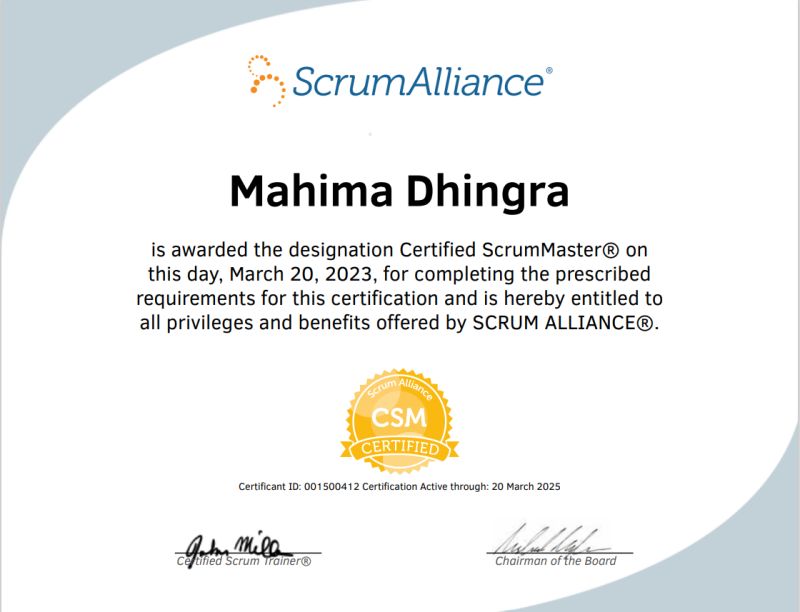What is the role of the Scrum Master in Agile?
- 1 Who is a Scrum Master?
- 2 Scrum Master Responsibilities
- 2.1 1. Coach team members
- 2.2 2. Support the Product Owner
- 2.3 3. Facilitate the resolution of Impediments
- 2.4 4. Educate the entire organization about Scrum Practices and Principles
- 2.5 5. Bridge the Communication Gap
- 2.6 6. Ensure team organization
- 3 The Significance of CSM Certification
- 4 Conclusion
The Scrum Master, often termed the “servant leader,” coaches and leads Agile teams. Their role involves educating on Agile processes, developing a high-performing team dynamic, and ensuring adherence to Scrum practices for progressive development. In this article, we’ll delve into the role of the Scrum Master in agile and explore the significance of the CSM certification in this context. Furthermore, in Agile leadership, the CSPO certification is a strategic extension. The CSPO is crucial in steering Agile teams, ensuring alignment with Scrum practices, and driving product development. This certification enhances your ability to optimize Agile processes and fosters a collaborative, product-centric approach within your Agile teams.
Who is a Scrum Master?
The Scrum Master is an expert in Scrum, coaching the team on its values, principles, and processes. While lacking full authority over strategic product decisions, the Scrum Master is accountable for the Scrum process and team effectiveness. The Scrum Guide outlines essential roles, rules, values, and rituals, providing a framework for optimal Scrum benefits.
Collaborating with the development team, Product Owner, and the entire organization, the Scrum Master coaches them in Scrum implementation. Implementing Scrum is challenging, as practitioners often adapt it to their context, showcasing the Scrum Master’s role as a servant leader.
Scrum Master Responsibilities
The Scrum Master, despite the title, isn’t the project or team leader. As described by Bryan Stallings, a Certified Scrum Trainer, the role combines Master-of-Ceremonies and Quartermaster expertise. The Scrum Master ensures the smooth progress of Scrum events, intervenes during impediments, and equips the team for success.
Responsibilities include facilitating, intervening when necessary, and providing essential support. The role emphasizes coordination and support rather than hierarchical control in agile project management.
1. Coach team members
The Scrum Master ensures team members are well-versed in Agile values, principles, Scrum events, and artefacts, fostering a self-managing and committed team. They reveal the team’s current state as a metaphorical mirror, promoting adaptation for higher performance. Through coaching, the Agile Scrum Master instils a shared sense of ownership and commitment.
While guiding the team on product scope, Scrum theory, and practices, the Scrum Master operates without formal people management responsibilities or individual accountability for project outcomes, emphasizing collective responsibility within Scrum teams.
2. Support the Product Owner
The product owner oversees creating and communicating the product backlog, focuses on customer value, and sets a long-term product goal. The Agile Scrum Master aids the Product Owner in refining the backlog and shaping the product goal through collaborative sessions with developers.
Together, they establish an empirical process for product planning, emphasizing clear communication and effective management of backlog items to achieve the overarching product objective.
3. Facilitate the resolution of Impediments
Team members identify distractions and roadblocks during each sprint that may hinder progress. The Agile Scrum Master collaborates with the team, other teams, and the organization to swiftly remove impediments the team cannot resolve independently.
This includes addressing issues like excessive unrelated meetings by working with organizers to streamline attendance or clarifying situations where team members are pulled in unrelated directions through collaboration with product owners and stakeholders.
4. Educate the entire organization about Scrum Practices and Principles
The Scrum Master is vital in driving Scrum implementation within the organization through training, coaching, and advising. Emphasizing Scrum philosophy, values, and structure, they guide adopting an empirical approach. Additionally, the Scrum Master facilitates interactions to cultivate openness, respect, and learning among stakeholders and the Scrum team.
5. Bridge the Communication Gap
In product development, a significant risk lies in the potential lack of clear communication between the product management team’s strategic vision and the developers executing the project. A key aspect of effective Scrum Mastery involves fostering a solid working relationship between the Agile Scrum Master, the product owner, and the product management team, promoting regular information sharing and mutual trust.
6. Ensure team organization
The Scrum Master’s primary responsibility is maintaining the development team’s organization and progress on prioritized projects. Leading daily standup meetings, the Scrum Master ensures discussions remain concise and acts on information gathered to eliminate obstacles.
They also facilitate Scrum events like sprint planning sessions, where their role involves listening, ensuring the team has necessary information, and capturing decisions to guide the agreed-upon plan. Essentially, the Scrum Master keeps the team on track and supports their effective collaboration in achieving project goals.
The Significance of CSM Certification
The CSM Certification Training is a popular course that enables professionals to use Scrum to maximize value and enhance productivity. CSM stands out as a highly desired certification among recruiters, witnessing a remarkable 61% growth in job listings.
Securing this certification showcases your commitment to staying informed about advancements in the Scrum domain, ensuring your ongoing relevance in the job market, and unlocking access to enhanced opportunities. Certified Scrum Masters command higher earnings, positioning them as valuable assets to any organization.
Common Scrum Master Mistakes
Common pitfalls for Scrum Masters include adopting a command-and-control style, often seen in project managers transitioning to Scrum Masters. This approach hinders the team from taking responsibility. Another pitfall is combining the roles of Scrum Master and Product Owner, as their distinct focuses may clash, compromising long-term team effectiveness.
Interfering with technical issues is a risk, especially when the Scrum Master has a technical background. Trusting the team’s ability to make sound technical decisions without unnecessary interference is crucial. Avoiding these pitfalls allows Scrum Masters to guide teams and foster agile principles effectively.
Necessary Scrum Master Skills
An exceptional Agile Scrum Master possesses a combination of technical and soft skills. They must be knowledgeable about the domain, technical issues, and the technologies the team uses, although expertise is not mandatory. Patience is crucial, allowing the team space to find answers independently. Collaboration skills are essential for working with various stakeholders, emphasizing transparency in communication.
Solid and soft skills include effective communication, leadership, facilitation, conflict resolution, flexibility, and adaptability. The Scrum Master must manage time efficiently, organize tasks, and understand Scrum values and principles. Hard skills encompass familiarity with Scrum tools, project management expertise, facilitation techniques, technical understanding, and analytical skills for data evaluation.
Conclusion
The annual compensation for a Certified Scrum Master in the United States is $122,236. The Scrum Master is the team’s protector, ensuring project smoothness and facilitating communication. Acting as a bridge between the product owner and development team, they streamline processes and resolve impediments. A successful Scrum Master navigates technical complexities and interpersonal dynamics, developing an environment where the Scrum team can thrive.



















